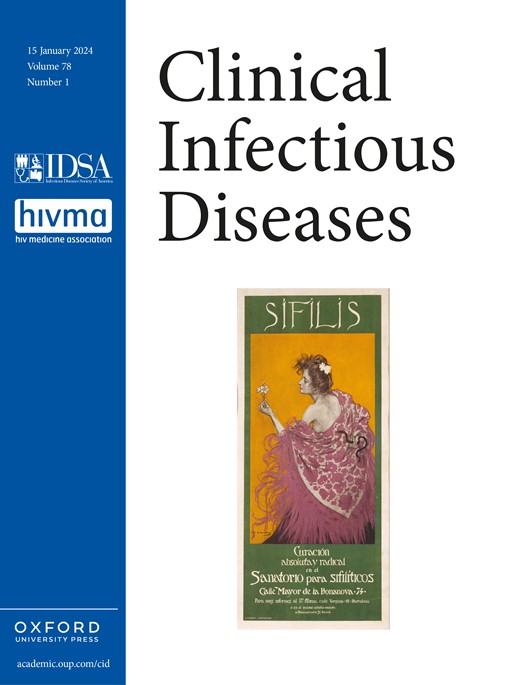Oral versus intravenous antibiotic therapy for Staphylococcus aureus bacteremia or endocarditis: a systematic review and meta-analysis of randomized controlled trials
IF 8.2
1区 医学
Q1 IMMUNOLOGY
引用次数: 0
Abstract
Background We conducted a systematic review of randomized controlled trials (RCTs) to generate more precise estimates of the efficacy and safety of oral versus intravenous antibiotic therapy for S. aureus bacteremia or endocarditis. Methods MEDLINE, EMBASE, the Cochrane Library, and Web of Science database were searched through February 21st, 2024. RCTs were included if they compared oral versus intravenous antibiotic therapy for S. aureus bacteremia or endocarditis, and appropriately reported outcomes for each group. Risk of bias was assessed using the revised Cochrane tool for assessing risk of bias in randomized trials. Heterogeneity between studies was evaluated with the Cochran’s Q-statistic and I2 test. Treatment effects were summarized with pooled risk ratios using a random effects model meta-analysis. (PROSPERO CRD42024481512) Results Only four RCTs met criteria for inclusion in meta-analysis. Among participants assessed for treatment failure, there was no difference between the oral and intravenous therapy groups (RR 0.99; 95% CI, 0.63–1.57; I2 = 0%). There was also no significant difference in adverse events between oral and intravenous therapy groups (RR 0.65; 95% CI, 0.07–5.94; I2 = 74%); however, the confidence interval is wide, and heterogeneity was high. Conclusions In this systematic review of RCTs comparing oral to intravenous antibiotic therapy for S. aureus bacteremia or endocarditis, few studies met eligibility criteria for inclusion. Meta-analysis of these studies suggests that transitioning from intravenous to oral therapy is likely effective in a subgroup of carefully selected patients. Additional randomized trials are necessary before transition to oral therapy can be routinely recommended.口服与静脉注射抗生素治疗金黄色葡萄球菌菌血症或心内膜炎:随机对照试验的系统回顾和荟萃分析
背景 我们对随机对照试验(RCT)进行了系统性回顾,以更精确地估计金黄色葡萄球菌菌血症或心内膜炎口服与静脉注射抗生素疗法的疗效和安全性。方法 在 2024 年 2 月 21 日前检索了 MEDLINE、EMBASE、Cochrane Library 和 Web of Science 数据库。如果RCT对金黄色葡萄球菌菌血症或心内膜炎的口服抗生素治疗与静脉注射抗生素治疗进行了比较,并适当报告了各组的治疗结果,则纳入这些RCT。采用修订后的 Cochrane 随机试验偏倚风险评估工具对偏倚风险进行评估。研究之间的异质性采用 Cochran 的 Q 统计量和 I2 检验进行评估。采用随机效应模型荟萃分析法总结了治疗效果,并汇总了风险比。(PROSPERO CRD42024481512)结果 只有四项研究符合纳入荟萃分析的标准。在接受治疗失败评估的参与者中,口服治疗组和静脉治疗组之间没有差异(RR 0.99;95% CI,0.63-1.57;I2 = 0%)。口服治疗组和静脉治疗组在不良事件方面也无明显差异(RR 0.65;95% CI,0.07-5.94;I2 = 74%);但置信区间较宽,异质性较高。结论 在这项比较金黄色葡萄球菌菌血症或心内膜炎口服和静脉注射抗生素治疗的 RCT 系统性综述中,符合纳入标准的研究很少。对这些研究进行的 Meta 分析表明,从静脉治疗过渡到口服治疗可能对经过严格筛选的亚组患者有效。在常规推荐过渡到口服疗法之前,有必要进行更多的随机试验。
本文章由计算机程序翻译,如有差异,请以英文原文为准。
求助全文
约1分钟内获得全文
求助全文
来源期刊

Clinical Infectious Diseases
医学-传染病学
CiteScore
25.00
自引率
2.50%
发文量
900
审稿时长
3 months
期刊介绍:
Clinical Infectious Diseases (CID) is dedicated to publishing original research, reviews, guidelines, and perspectives with the potential to reshape clinical practice, providing clinicians with valuable insights for patient care. CID comprehensively addresses the clinical presentation, diagnosis, treatment, and prevention of a wide spectrum of infectious diseases. The journal places a high priority on the assessment of current and innovative treatments, microbiology, immunology, and policies, ensuring relevance to patient care in its commitment to advancing the field of infectious diseases.
 求助内容:
求助内容: 应助结果提醒方式:
应助结果提醒方式:


